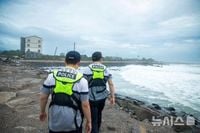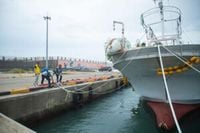As Typhoon Wutip advances northward, local authorities across South Korea are ramping up efforts to safeguard communities and maritime activities from potential flooding and storm-related dangers. From Hwaseong and Changwon cities on the mainland to the island of Jeju, officials are mobilizing resources, inspecting vulnerable areas, and activating emergency response systems to minimize damage and protect lives.
In Hwaseong Special City, Mayor Jeong Myeong-geun personally inspected flood-prone zones, emphasizing the city’s proactive stance ahead of the expected heavy rains. Recognizing the unique geography of the Sagang market area, which lies lower than the normal river level, the city has installed automatic floodgates at the Bonggacheon drainage outlet. These gates are designed to close when intense rainfall is forecasted, preventing the river from flowing backward and flooding the adjacent neighborhoods.
Last year’s severe flooding prompted Hwaseong to install temporary pump stations in the Sagang-ri area, a hotspot for recurrent inundation, and the city continues to maintain these facilities diligently. The city’s emergency duty system is fully operational, with maintenance teams on standby across different zones to ensure swift on-site intervention during any flooding event.
Looking ahead, Hwaseong has earmarked the Balan and Sagang districts as priority zones for flood control. With a substantial investment of 24.8 billion KRW planned through 2027, the city will implement the 'Urban Flood Response Project' aimed at installing new pumping stations, renovating aging drainage pipes to boost water flow capacity, and installing manhole fall prevention devices to enhance citizen safety. Mayor Jeong stressed the importance of thorough inspections of flood response infrastructure and urged local leaders to establish rapid response protocols to protect residents’ lives and property from typhoon-related hazards.
Meanwhile, in Changwon Special City, Acting Mayor Jang Geum-yong led a series of on-site inspections on June 13, targeting flood-prone areas and locations that suffered extreme rainfall damage last year. The inspections focus on Wolyeong-dong in Masanhappo-gu and the seawall area of Whiteville in Sanho-dong, where officials are reviewing the status of rainwater inlet cleaning, culvert and river facility maintenance, evacuation plans for residents, and seawall restoration progress.
Acting Mayor Jang highlighted the growing frequency of extreme weather events, underlining the vital need for meticulous pre-storm preparations. He called for rigorous preventive actions, including clearing drain inlets and promoting responsible trash disposal, to ensure no citizen falls victim to avoidable flooding or storm damage.
On the maritime front, the Jeju Regional Coast Guard Headquarters is leaving no stone unturned in its efforts to manage the indirect impacts of Typhoon Wutip, which formed in the South China Sea on June 11 and is expected to weaken into a tropical depression after making landfall on mainland China around June 16. Although South Korea will not face a direct hit, rough sea conditions are anticipated until June 17, particularly around Jeju and Seogwipo waters.
Jeju Coast Guard Chief Park Sang-chun convened a situation assessment meeting on June 13, reviewing departmental readiness and reinforcing safety management protocols. The Coast Guard has initiated intensive safety operations, including early evacuation advisories for fishing vessels operating in distant waters and continuous monitoring of maritime traffic in Jeju’s surrounding waters.
In addition, the Coast Guard is focusing on the safety of moored vessels within ports, working to prevent marine pollution, and enforcing entry restrictions in hazardous zones. To keep the public informed, hazard warnings are being broadcast through electronic display boards, banners, and social media channels. Furthermore, patrols have been intensified along coastlines and breakwaters prone to rogue waves to prevent accidents such as falls.
The Seogwipo Coast Guard Station has issued a 'Cautionary Warning' under the coastal safety accident risk forecast system, signaling the potential for strong winds reaching up to 16 meters per second and waves as high as 3 meters from June 13 through June 17. This warning is a call to heightened vigilance, given the forecasted adverse weather conditions.
Chief Park affirmed the Coast Guard’s commitment to what he described as “over-preparation” in safeguarding the public. “We will do our utmost to minimize safety accidents and respond swiftly to any incidents to protect the lives and property of our citizens,” he stated.
Across these regions, the coordinated efforts reflect an acute awareness of the increasing threats posed by climate change and extreme weather phenomena. The combination of infrastructural upgrades, emergency preparedness, and public communication aims to mitigate the risks associated with Typhoon Wutip and the approaching monsoon season.
As these proactive measures unfold, residents are encouraged to stay informed, heed official advisories, and cooperate with local authorities to navigate the challenges posed by this year’s first typhoon and the rainy season ahead.





